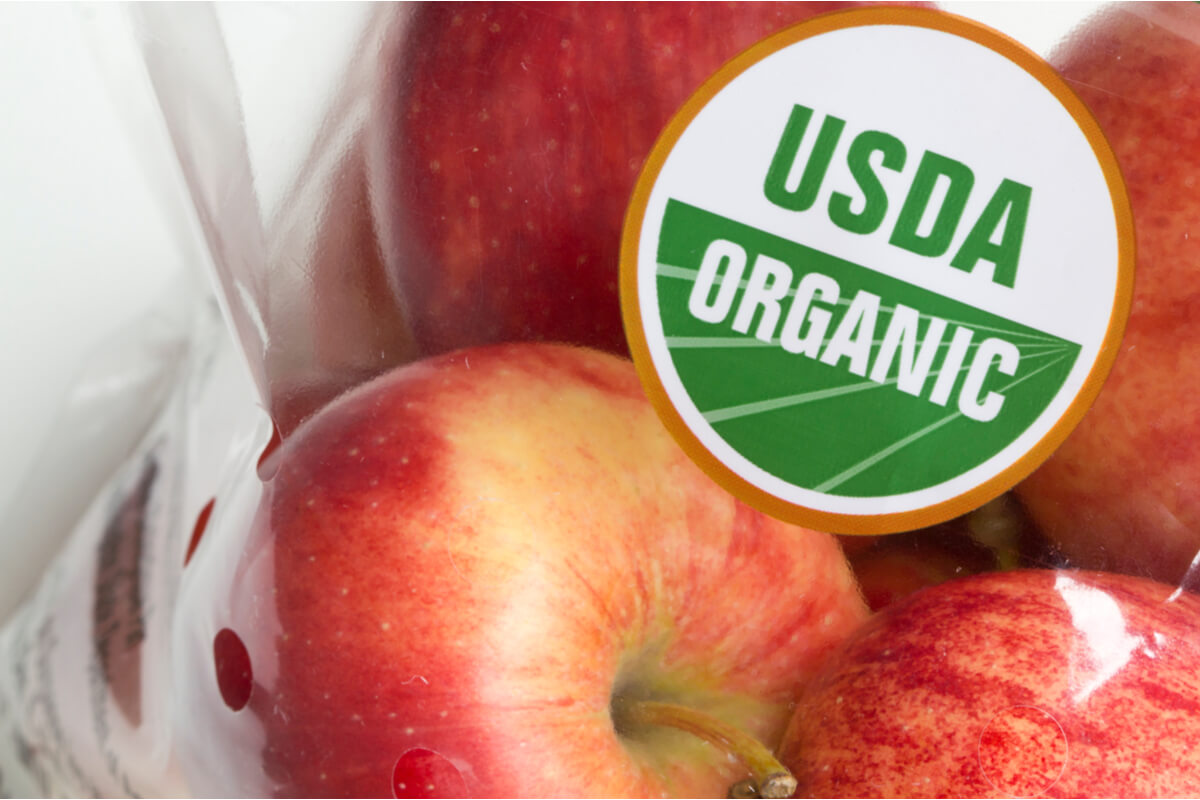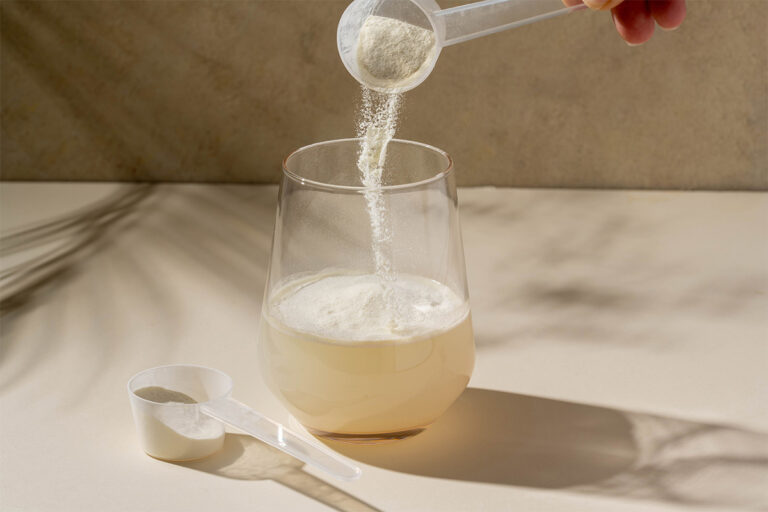Organic food may have started out as a niche offering in the 1970s, but today, it seems like organic products are everywhere! According to the Organic Trade Association (OTA), sales of organic goods topped $55 billion in 2019—a good indication that more consumers are choosing organic than ever before. (19)(23) What does organic mean? Here, we’ll unpack the nuances of organic food claims and whether you might want to add organic goods to your shopping list.
Organic basics
Before the widespread use of agricultural chemicals like dichloro-diphenyl-trichloroethane (DDT) beginning in the 1940s, all farming could have been considered organic. (10) As more crops were subject to being treated with chemicals, studies began to surface exploring the adverse health effects of these chemicals. (3)(14)(2) This led some consumers to seek out healthier alternatives—and for many that meant choosing organic. However, the organic certification was different in each state, which made it hard for consumers to know what they were getting. In an effort to standardize organic farming, the Organic Foods Production Act was passed in 1990. In 2002, the U.S. Department of Agriculture (USDA) then released its first national certification program for organic products, officially bringing the movement from a niche market into the mainstream. (23)
Quality supplement plans in less than a minute
At its core, today’s organic foods are defined as those that are grown and processed according to federal guidelines addressing, among many factors, soil quality, animal raising practices, pest and weed control, and the use of additives. Under the USDA’s certification program, farmers, ranchers, and organic producers are required to document how they grow, raise, and process their crops, animals, or goods. They must also undergo an annual inspection to make sure they are in compliance. (12)
Produce can sport the USDA’s organic label if it’s certified to have been grown on soil that has had no prohibited substances (e.g., synthetic fertilizers, pesticides, or herbicides) applied during the three years prior to harvest. Meat, on the other hand, can be considered organic if the animals are fed 100% organic feed, not given antibiotics or hormones, and raised in conditions that support their natural behaviors, such as grazing. (12) The USDA doesn’t currently certify farmed fish; however, standards are currently being proposed. (16)

What does organic mean?
Summarized below, the USDA currently has four distinct labeling categories for organic products. (13)
100% Organic
If a food bears a 100% Organic label, it must be made of 100% certified organic ingredients from a producer that undergoes an annual inspection by a certifying agent. These foods are allowed to use the USDA’s official organic seal, which must also include the name of the certifying agent. (13)
Organic
If a food is simply marked “organic,” the product and its ingredients must be certified organic except when specified in the National List of Allowed and Prohibited Substances. This list includes non-synthetic additives like carrageenan or citric acid and synthetic ingredients like ascorbic acid or xanthan gum. (15) However, the USDA stipulates that no more than 5% of the combined total ingredients can be made up of non-organic ingredients on this list. What’s more, the label must include the name of the certifying agent. Both certified organic and 100% organic foods can use the USDA Organic Seal and/or the claim “organic” on their packaging. (13)
Made with organic ingredients
For products containing both organic and non-organic ingredients, food manufacturers can use the “Made with organic ingredients” label if the product contains at least 70% certified organic ingredients. However, only a maximum of three ingredients or ingredient categories can be represented as organic. Although the remaining ingredients don’t have to be organic, they cannot be genetically modified. All non-agricultural ingredients in the product must be among those that are allowed on the National List of Allowed and Prohibited Substances. For example, processed organic food may contain some approved non-agricultural ingredients like enzymes in yogurt, pectin in fruit jams, or baking soda in baked goods. (13)
Specific organic ingredients
Products that contain some organic ingredients but less than 70% fall under the “specific organic ingredients” category. These foods don’t need to be certified; however, manufacturers can’t display the USDA Organic seal on the label. They also can’t prominently use the word organic on the principal display panel (e.g., the front label). Manufacturers can, however, list certified organic ingredients and the percentage of those ingredients on the ingredient list. (13)

Organic vs. conventional food
Now that you know what to look for, let’s talk about why you may want to consider opting for organic food. Unlike conventional fruits, vegetables, dairy, or meat, certified organic food isn’t subjected to synthetic pesticides, herbicides, or other synthetic compounds. As a result, organic consumers are eating food with significantly lower levels of chemical residue. (9) Studies also show that organic foods contain lower levels of some heavy metals like cadmium, which has been linked to a range of health issues including chronic kidney problems, osteoporosis, diabetes, and cardiovascular disease. (24)(7) On the other hand, one recent review of 35 studies reported that people routinely adding more organic food to their meals had a reduced risk of:
- Allergies
- Birth defects
- Ear infections
- Elevated cholesterol
- High blood pressure
- High body mass index (BMI)
- Infertility
- Metabolic syndrome
- Pre-eclampsia
- Non-Hodgkin’s lymphoma
- Type 2 diabetes (6)(24)
Some research also suggests that organic food may also be more nutritious. A growing number of studies show that organic fruits and vegetables contain higher antioxidant levels. (5)(21) One review of 41 studies found that, on average, organic fruits and vegetables offer 27% more vitamin C, 21% more iron, 29% more magnesium, and 13% more phosphorus than their conventional counterparts. (26) Organic dairy and meat has also been found to contain higher levels of omega-3 fatty acids. (20)(22)
While there are many benefits of buying organic, be aware that these benefits come with a cost since many organic foods are more expensive than conventionally grown foods. This is largely due to several factors such as a limited supply and higher production costs. (25)
Did you know? Dietary supplements fall outside the USDA’s National Organic Program (NOP), even though they may contain food or herbal extracts. Their ingredients may be certified organic under the program; however, it is not required by law. (18)
Beyond organic: essential oils and more
Although most people think of food when they think of organics, there are an array of organic products available, from mattresses to toys to feminine protection. Among the most popular are organic essential oils, cosmetics, and personal care products. Do these products fall under the same rules as organic food?

Essential oils—organic or not—aren’t strictly regulated under the U.S. Food and Drug Administration (FDA) unless they make drug claims. They also aren’t required to be approved by the FDA before they go on the market. (4) This is also the case for cosmetics and personal care products. (11) The FDA can only take action if an essential oil, cosmetic, or personal care product is shown to be mislabeled or unsafe after it’s available for sale in brick and mortar or online stores. (11) What’s more, the FDA doesn’t have regulations defining the terms “natural” or “organic” for cosmetics. (17) However, if these products are labeled as organic, they must comply with both the USDA’s rules governing the use of organic claims and the FDA’s labeling regulations. If a cosmetic, body care product, or personal care product contains or is made up of agricultural ingredients and can meet the USDA’s NOP standards, it may be eligible for organic certification. Once certified, companies are permitted to display the NOP organic claim on the label. (8)
If they meet NOP standards, other products that claim to be organic can also fall under one of the four organic claims and, if required, undergo the certification process. This includes goods like textiles (e.g., clothing, mattresses), alcoholic beverages, dietary supplements, and pet food. (1)
The bottom line
Buying organic food and other goods may help minimize your exposure to potentially harmful agricultural chemicals. What’s more, some studies show that organic produce may also be more nutritious. However, the choice to purchase organic is highly personal based on your values and budget.If you do choose to purchase organic, look for the “USDA Organic” seal or the “Made with organic ingredients” designation on the label. This ensures that the food or product is truly certified organic or contains certified organic ingredients.
Quality supplement plans in less than a minute
- About organic labeling. U.S. Department of Agriculture. https://www.ams.usda.gov/rules-regulations/organic/labeling#textile%20labeling
- Agostini, L.P., Dettogni, R.S., dos Reis, R.S., Stur, E., dos Santos, E.V.W., Ventorim, D.P., Garcia, F.M., … Louro, I.D. (2020). Effects of glyphosate exposure on human health: insights from epidemiological and in vitro studies. Science of the Total Environment, 705, 135808.
- Alavania, M.C.R. (2010). Pesticide use and exposure extensive worldwide. Review of Environmental Health, 24(4), 303-309.
- Aromatherapy. (2020). U.S. Food & Drug Administration. https://www.fda.gov/cosmetics/cosmetic-products/aromatherapy
- Baranski, M., Srednicka-Tober, D., Volakakis, N., Seal, C., Sanderson, R., Stewart, G.B., Benbrook, C., … Leifert, C. (2014). Higher antioxidant and lower cadmium concentrations and lower incidence of pesticide residues in organically grown crops: a systematic literature review and meta-analysis. British Journal of Nutrition, 112(5), 794-811.
- Baudry, J., Méjean, C., Péneau, S., Galan, P., Hercberg, S., Lairon, D., & Kesse-Guyot, E. (2015). Health and dietary traits of organic food consumers: results from the NutriNet-Santé study. British Journal of Nutrition, 114(12), 2064-2073.
- Chunhabundit, R. (2016). Cadmium exposure and potential health risk from foods in contaminated area, Thailand. Toxicological Research, 32(1), 65-72.
- Cosmetic, body care, and personal care products. U.S. Department of Agriculture. https://www.ams.usda.gov/grades-standards/cosmetics-body-care-and-personal-care-products?dDocName=STELPRDC5068442
- Cressey, P., Vannoort, R., & Malcolm, C. (2009). Pesticide residues in conventionally grown and organic New Zealand produce. Food Additives & Contaminants: Part B, 2(1), 21-26.
- DDT regulatory history: a brief survey (to 1975). (1975). U.S. Environmental Protection Agency. https://archive.epa.gov/epa/aboutepa/ddt-regulatory-history-brief-survey-1975.html
- FDA authority over cosmetics: How cosmetics are not FDA-approved but are FDA-regulated. (2021). U.S. Food & Drug Administration. https://www.fda.gov/cosmetics/cosmetics-laws-regulations/fda-authority-over-cosmetics-how-cosmetics-are-not-fda-approved-are-fda-regulated
- McEvoy, M. (2019). Organic 101: What the USDA Organic label means. U.S. Department of Agriculture. https://www.usda.gov/media/blog/2012/03/22/organic-101-what-usda-organic-label-means
- McEvoy, M. (2017). Understanding the USDA organic label. U.S. Department of Agriculture. https://www.usda.gov/media/blog/2016/07/22/understanding-usda-organic-label
- Mesnage, R., Defarge, N., Spiroux de Vendômois, J., & Séralini, G. (2014). Major pesticides are more toxic to human cells than their declared active principles. BioMed Research International, 2014, 179691.
- Nonagricultural (nonorganic) substances allowed as ingredients in or on processed products labeled as “organic” or “made with organic (specified ingredients or food group(s)).” Electronic Code of Federal Regulations. §205.605. U.S. Department of Agriculture. https://www.ecfr.gov/cgi-bin/text-idx?c=ecfr&SID=06b088e611c5f18a4d02ca9945a1c3dd&rgn=div8&view=text&node=7:3.1.1.9.32.7.354.6&idno=7
- Organic aquaculture. U.S. Department of Agriculture. https://www.nal.usda.gov/afsic/organic-aquaculture
- “Organic” cosmetics. (2020). U.S. Food & Drug Administration. https://www.fda.gov/cosmetics/cosmetics-labeling-claims/organic-cosmetics
- Organic labeling requirements. NSF International. https://www.nsf.org/knowledge-library/organic-labeling-requirements
- Organic market overview: organic industry survey. (2020). Organic Trade Association. https://ota.com/organic-market-overview/organic-industry-survey
- Ribas-Agusti A., Diaz I., Sarraga C., Garcia-Regueiro J.A., & Castellari M. (2019). Nutritional properties of organic and conventional beef meat at retail. Journal of the Science of Food and Agriculture, 99, 4218–4225.
- Søltoft, M., Bysted, A., Madsen, K.H., Mark, A.B., Bügel, S.G., Nielsen, J., & Knuthsen, P. (2011). Effects of organic and conventional growth systems on the content of carotenoids in carrot roots, and on intake and plasma status of carotenoids in humans. Journal of the Science of Food and Agriculture, 91, 767–775.
- Srednicka-Tober D., Baranski M., Seal C., Sanderson R., Benbrook C., Steinshamn H., Gromadzka-Ostrowska J., … Eyre M. (2016). Composition differences between organic and conventional meat: A systematic literature review and meta-analysis. British Journal of Nutrition, 115, 994–1011.
- The history of organic farming in the United States. Sustainable Agriculture Research & Education. https://www.sare.org/publications/transitioning-to-organic-production/history-of-organic-farming-in-the-united-states/
- Vigar, V., Myers, S., Oliver, C., Arellano, J., Robinson, S., & Leifert, C. (2020). A systemic review of organic versus conventional food consumption: is there a measurable benefit on human health? Nutrients, 12(1), 7.
- Why is organic food more expensive than conventional food? Organic Agriculture. World Health Organization. https://www.fao.org/home/en/
- Worthington, V. (2001). Nutritional quality of organic versus conventional fruits, vegetables, and grains. The Journal of Alternative and Complementary Medicine, 7(2), 161-173.





